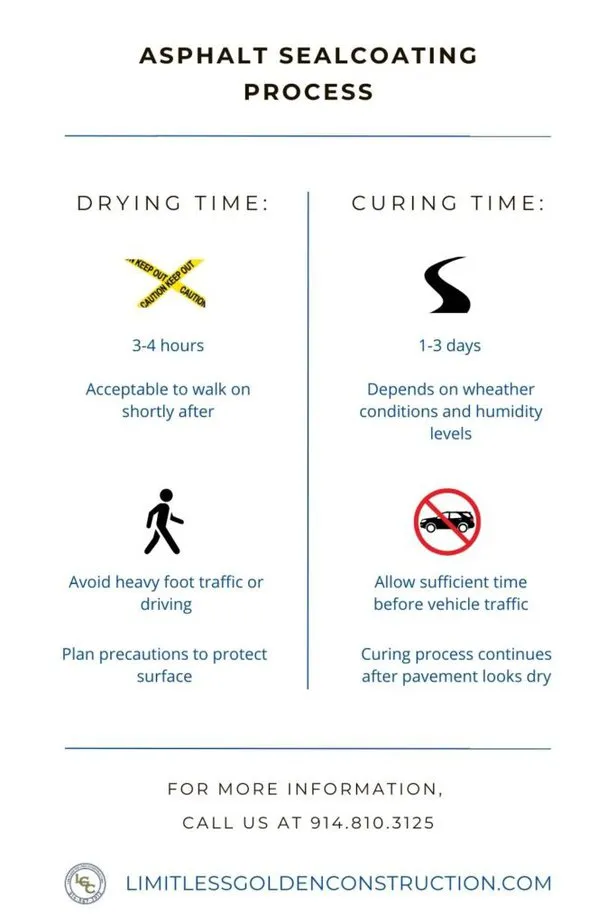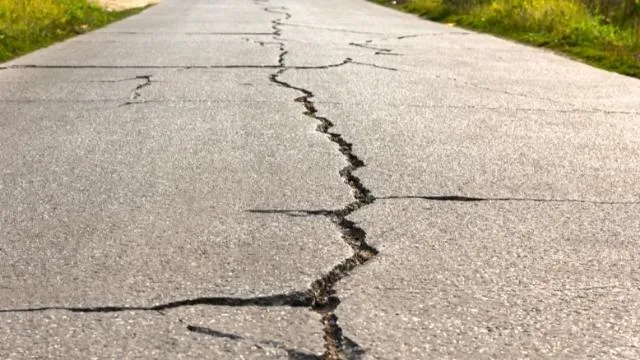Asphalt sealcoating is an important maintenance step to protect and extend the lifespan of your pavement. Consider how long it takes for the sealcoat to dry and cure before you can safely use your driveway or parking lot.
According to our seasoned asphalt sealcoating professionals, here’s what you need to know about the drying time for asphalt sealcoating:
- Drying Time: Generally, average asphalt sealcoating drying times take around three to four hours. During this time, it is acceptable to walk on the surface without causing any damage. However, it’s still best to avoid any heavy foot traffic during this initial drying phase.
- Curing Time: While the sealcoat may feel dry after a few hours, it takes longer to fully cure. The curing process typically takes one to three days, depending on factors such as weather conditions and humidity levels. It’s essential to allow sufficient curing time before subjecting the surface to vehicle traffic.

It’s worth noting that the curing process continues even after the surface appears dry. To ensure the proper curing of your sealcoated driveway, it is recommended to refrain from using it for two days. While it is safe to walk on shortly after sealcoating, we advice to wait 48 hours before driving on it. This waiting period allows sufficient time for the sealant to fully dry and cure, ensuring optimal durability and performance.
By understanding drying and curing times of asphalt sealcoating, you can plan and take necessary precautions to protect your pavement. Investing in regular sealcoating maintenance can help preserve the integrity and longevity of your asphalt surface.
If you have further questions or want to learn more about sealcoating, reach out to trusted professionals in the industry.
Note: The information provided is based on industry practices and recommendations. Individual product instructions may vary! So it’s crucial to refer to the specific manufacturer’s guidelines for precise drying and curing times.
What Is The Difference Between Asphalt Crack Filling and Asphalt Sealcoating?
Asphalt crack filling and asphalt sealcoating are both important maintenance processes for asphalt surfaces, but they serve different purposes.
Crack filling involves filling in small cracks and fissures in the asphalt using a specialized rubberized tar filler. This helps prevent water from penetrating the cracks and causing further damage. Crack filling is typically done as a reactive measure to address existing cracks and prevent them from expanding.

On the other hand, sealcoating is a proactive process that involves applying a protective layer of sealant to the entire surface of the asphalt. This sealant acts as a barrier against moisture, UV rays, and other elements that can damage the asphalt over time. Sealcoating helps to extend the life of the pavement, enhance its appearance, and provide a smoother surface for vehicles and pedestrians.
In summary, crack filling is focused on repairing existing cracks, while sealcoating is a preventive measure to protect the entire asphalt surface. Both processes play important roles in maintaining the longevity and durability of your asphalt surfaces.
When Is the Best Time of Day to Seal Asphalt Pavement?
Choosing the best time to seal asphalt involves considering weather and temperature. Sealcoating is not limited to summer months. The ideal time is between 50-90°F with no rain within 48 hours.
It’s also important to consider the amount of sunlight that will be hitting the surface while it’s drying. Avoid sealcoating in direct sunlight to prevent premature drying and cracking of the sealcoat.
To ensure successful sealcoating, choose a time with moderate temperatures and favorable weather conditions.
This could mean sealcoating in early spring or late fall in NY & CT, as these seasons offer ideal conditions. It’s always recommended to consult local service providers for specific instructions on timing. Proper sealcoating preserves the integrity of your pavement and considering drying/curing times and weather ensures a successful project.
Our professionals recommend the first asphalt sealcoating treatment to be done one year after the original installation of asphalt pavement. The frequency after the initial sealcoat should be no more than two years apart to guarantee best protection of your asphalt surfaces.
Should You Seal Your Asphalt Pavement Before It Snows?
Wondering if you should seal your asphalt surfaces before winter? Yes, it’s essential to protect your pavement from harsh weather by sealing it beforehand.
Sealcoating helps to prevent damage caused by snow and ice accumulation over the winter months. It also helps form a protective barrier that prevents moisture from seeping into your pavement causing cracks or other damage.
However, it’s important to note that sealcoating should be done well before the snow starts falling to allow enough time for proper drying and curing of the sealant. As mentioned previously, this typically takes one to three days, depending on weather conditions and other factors.

Therefore, if you’re planning to seal your asphalt pavement before winter sets in, it’s important to be proactive. This way, you can ensure that the sealant has had enough time to dry and cure properly– allowing for optimal protection of the surface throughout the harsh winter months.
Sealcoating preserves and extends the lifespan of your pavement. Understand drying and curing times for proper sealing. Protect your asphalt from winter with necessary measures. Regular maintenance ensures long-lasting pavement.
Following Up After Sealcoating Pavement
Regular inspections of your pavement can help you to identify any issues that may arise, such as cracks or potholes.
- Seek guidance from professionals for expert sealcoating advice, including scheduling and product selection.
- Determine the ideal frequency for reapplication to ensure long-lasting protection for your property.
- Invest time and effort into regular maintenance to keep your asphalt pavement in excellent condition.
If needed, a professional service provider can repair the asphalt quickly and easily– with minimal disruption or downtime.
How Much Does Asphalt Sealcoating Cost?
The cost of sealcoating your driveway or parking lot will depend on a variety of factors, such as the size and complexity of the surface to be sealed. For instance, larger pavements may require more material and labor time– resulting in higher costs.
In general, asphalt sealcoating costs between $0.20 to $0.45 per square foot in New York and Connecticut (as of September 2023). This is dependent on the condition of your pavement, the location of the project, and the products used. A professional service provider can provide you with a more accurate estimate after inspecting your asphalt surface.
Sealcoating is vital for preserving your driveway or parking lot long-term, despite its higher cost.
Regular sealcoating maintenance extends the life of your asphalt surface and shields it from damage, ultimately saving money.
Overall, asphalt sealcoating is a cost-effective way to maintain and preserve your pavement for many years. By understanding the necessary drying times, weather conditions, and other requirements, you can ensure that your asphalt is protected from wear and tear. As a result, your driveway or parking lot will remain looking its best for years to come.

At Limitless Golden Construction we are happy to aid you with your upcoming asphalt maintenance or installation project. We are the leaders for residential paving, sealcoating, and masonry services in Westchester County, Putnam County, Fairfield County, and surrounding areas of Peekskill New York.Claim your complimentary quoteoruse our FREE online paving calculator.Be proactive, calculate your paving costs, trust the pros!